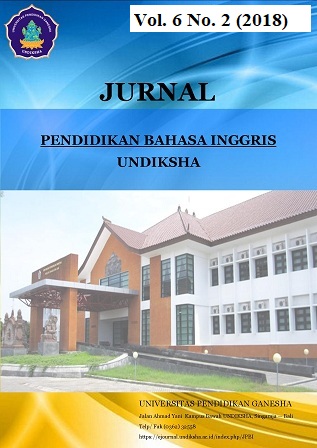THE PROFILE OF TEACHERS’ TECHNIQUES, MEDIA AND MATERIAL OF TEACHING ENGLISH VOCABULARY TO YOUNG LEARNERS APPLIED AT AURA SUKMA INSANI KINDERGARTEN (A CASE STUDY)
DOI:
https://doi.org/10.23887/jpbi.v6i2.20586Abstract
Abstract
This research aimed to describe (1) the teachers’ techniques, media and material in teaching English vocabulary to young learners at Aura Sukma Insani Kindergarten and (2) the problems faced by the teachers in applying the techniques, media and material in teaching vocabulary. This research was a case study under the form of qualitative design. The subjects of the study were the English teachers in Aura Sukma Insani Kindergarten. The instruments used in collecting the data were the researcher herself, interview guide, video recorder, observation checklist and field note. The data analysis was conducted through four stages namely data collection, data reduction, data display and conclusion drawing. The result of analysis showed that the teachers applied various teaching strategies with the support of various teaching media to teach vocabulary. The variation enabled the students to have much exposure to the vocabularies. Moreover, the problems faced by the teachers in teaching vocabulary were about the students’ behavioral management, attention management and dependence toward their teachers.
Key words: technique, media, material, vocabulary, young learnersReferences
Arianto, Yopi. (2003). A study on the use of media in teaching vocabulary to young learners. Unpublished thesis, Muhammadiyah University of Malang. Retrieved from http://digilib.umm.ac.id/files/disk1/39/jiptummpp-gdl-s1-2005-yopiariant-1937-contents.pdf. Accessed on January 8th 2014
Beare, Kenneth. (2014). English dialogue for young learners [Blog post]. Retrieved from http://esl.about.com/od/businessenglishdialogues/a/b_dialogues.htm. Accessed on June, 1st 2014
Cameron, Lynne. (2001). Teaching languages to young learners. Cambridge University Press: Cambridge. Retrieved from http://en.bookfi.org/s/?q=young+learners&t=0. Accessed on May 8th 2014
Huyen, Nguyen Thi Thanh & Nga, Khuat Thi Thu. (2003). Learning vocabulary through games: The effectiveness of learning vocabulary through games. Asia EFL Journal. Retrieved from http://www.gsedu.cn/tupianshangchuanmulu/zhongmeiwangluoyuyan/learning%20vocabulary%20through%20games.pdf. Accessed on March, 26th 2013
Lestari, Marintan Widi & Latief, Mohammad Adnan. (2012). Teacher’s techniques of introducing new vocabulary to young learners at TK AR Rahman Jombang. Unpublished Thesis, State University of Malang. Retrieved from http://jurnal-online.um.ac.id/data/artikel/artikelF47BF47778F3A545EBE03502937CBBC9.pdf. Accessed on February, 8th 2013
Nassir, Merriam E Al. (2012). Meaning recall and retention: comparison between translation method and pictorial method in learning vocabulary in Saudi’s school. Unpublished Thesis, Colorado State University. Retrieved from http://digitool.library.colostate.edu///exlibris/dtl/d3_1/apache_media/L2V4bGlicmlzL2R0bC9kM18xL2FwYWNoZV9tZWRpYS8xNjE5MjE=.pdf. Accessed on February, 8th 2013
Nunan, David. (2005). Practical English Language Teaching: Young Learners. New York: Mc Graw-Hill
Rhalmi, Mohammed. (2006). The audio-lingual method [Blog post]. Retrieved from http://www.myenglishpages.com/blog/the-audiolingual-approach/. Accessed on March, 18th 2014
Siscova, Dagmar. (2008). Teaching vocabulary through music. Unpublished thesis, Masaryk University. Retrieved from http://is.muni.cz/th/237375/pedf_m/Teaching_Vocabulary_through_Music.pdf. Accessed on March, 25th 2013
Thornbury, S. (2002). How to teach vocabulary. Harlow: Pearson Education
Undang – Undang Dasar Negara Republik Indonesia Tahun 1945. Retrieved from http://www.dpr.go.id/id/uu-dan-ruu/uud45. Accessed on May 5th 2014
Undang – Undang Republik Indonesia Nomor 20 Tahun 2003. Retrieved from http://www.dikti.go.id/files/atur/UU20-2003Sisdiknas.pdf. Accessed on May 5th 2014
Wahyuni, Ni Made. (2012). An Analysis of Students’ Achievement in Learning English Vocabulary at Grade Five at the Primary School No. 6 Dajan Peken Tabanan in Academic Year 2012. Unpublished thesis, Universitas Pendidikan Ganesha
Downloads
Published
Issue
Section
License
Authors who publish with the Jurnal Pendidikan Bahasa Inggris Undiksha agree to the following terms:- Authors retain copyright and grant the journal the right of first publication with the work simultaneously licensed under a Creative Commons Attribution License (CC BY-SA 4.0) that allows others to share the work with an acknowledgment of the work's authorship and initial publication in this journal
- Authors are able to enter into separate, additional contractual arrangements for the non-exclusive distribution of the journal's published version of the work (e.g., post it to an institutional repository or publish it in a book), with an acknowledgment of its initial publication in this journal.
- Authors are permitted and encouraged to post their work online (e.g., in institutional repositories or on their website) prior to and during the submission process, as it can lead to productive exchanges, as well as earlier and greater citation of published work. (See The Effect of Open Access)













